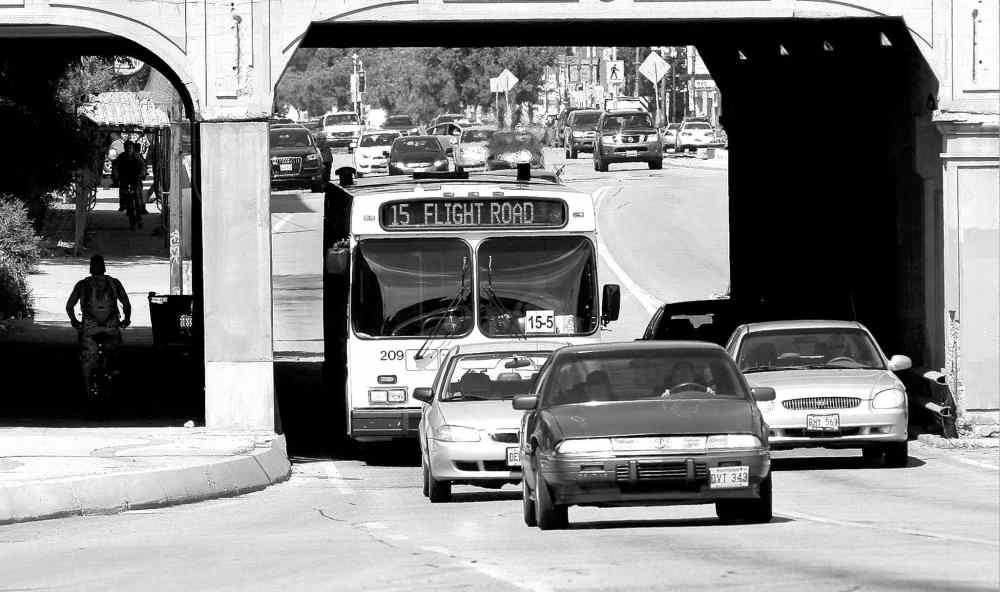Transit and roads not mutually exclusive
Advertisement
Read this article for free:
or
Already have an account? Log in here »
To continue reading, please subscribe:
Monthly Digital Subscription
$0 for the first 4 weeks*
- Enjoy unlimited reading on winnipegfreepress.com
- Read the E-Edition, our digital replica newspaper
- Access News Break, our award-winning app
- Play interactive puzzles
*No charge for 4 weeks then price increases to the regular rate of $19.00 plus GST every four weeks. Offer available to new and qualified returning subscribers only. Cancel any time.
Monthly Digital Subscription
$4.75/week*
- Enjoy unlimited reading on winnipegfreepress.com
- Read the E-Edition, our digital replica newspaper
- Access News Break, our award-winning app
- Play interactive puzzles
*Billed as $19 plus GST every four weeks. Cancel any time.
To continue reading, please subscribe:
Add Free Press access to your Brandon Sun subscription for only an additional
$1 for the first 4 weeks*
*Your next subscription payment will increase by $1.00 and you will be charged $16.99 plus GST for four weeks. After four weeks, your payment will increase to $23.99 plus GST every four weeks.
Read unlimited articles for free today:
or
Already have an account? Log in here »
Hey there, time traveller!
This article was published 06/10/2014 (4069 days ago), so information in it may no longer be current.
Public transit is often assumed to come at the expense of good roads, and vice versa. But it doesn’t have to be that way.
There are certainly cases where roadway spending and public transit are at odds. For instance, when light rail or streetcar projects remove lanes of traffic, or when road design doesn’t accommodate buses. But in many other cases, roadway improvements and transit projects are symbiotic. After all, both cars and buses use the streets. Better road maintenance and design can give both transit riders and drivers faster and more pleasant commutes.
Often, in debates over public transportation, there is an assumption that transit benefits downtown residents while roads benefit suburban residents. While that is where the political fault lines are drawn, day-to-day reality isn’t that simple. Many downtown dwellers rarely use transit, opting to walk or cycle instead. By contrast, many suburban residents rely on transit to get around. Indeed, mass transit in many cities is mainly oriented towards moving people between the core and the suburbs.

Roads and public transit are important to urban and suburban residents. It is also possible to improve both simultaneously in many instances. As a simple example, potholes are just as unpleasant for bus riders as they are for drivers. Filling in potholes is beneficial to both transit riders and drivers.
Given buses share the road with drivers, designing roads to minimize the conflict between the two can be mutually beneficial. Local buses making frequent stops inherently slows traffic down. Measures such as dedicated bus lanes can mitigate this. They reduce the number of cars merging to avoid buses and they eliminate the need for buses to swerve in and out of the curb lane to avoid parked cars. The Transportation Research Board lists these moves as cost effective ways to maximize road capacity. Jurisdictions such as Halifax, York Region, and Vancouver have used this approach. In Winnipeg, examples are found on Osborne at McMillan northbound and Osborne at River southbound.
A more expensive example is grade separation. Sometimes it makes sense to allow transit to bypass traffic entirely. Ottawa’s Transitway is a prime example. Built as an exclusive bus route primarily aimed at moving bus riders from the suburbs to the core, it bypasses traffic by travelling above or below grade. Getting buses off of the road and into a dedicated busway can not only increase overall road capacity, it also improves traffic flow, with fewer buses starting and stopping in traffic.
The first leg of Winnipeg’s rapid transit system includes a busway portion similar though much less extensive than Ottawa’s. The southwest transitway allows buses to pass over Osborne Street onto a dedicated busway that runs along Donald then Stradbrook, allowing it to bypass traffic en route to Main Street. This grade separation works for both transit riders and drivers because buses don’t have to wait for motorists and vice versa.
Focusing on mutually beneficial infrastructure projects should be a priority. Indeed, Winnipeg’s planned rapid transit network would follow this route. Funding it won’t be easy, given the financial state of the city and province. However, it shouldn’t be viewed as parasitic to roadway funding. It will improve roadways for drivers and take some number of drivers off the street altogether, mitigating congestion.
Granted, projects across North America suggest that we should temper our expectations. Winnipeg will never have the transit ridership levels seen in Toronto or New York. The city isn’t built that way. But judging from the success of bus rapid transit projects in cities like Cleveland and Kansas City, there is good reason to believe that Winnipeg’s BRT system will put a dent in our traffic woes.
Public transit doesn’t have to come at the expense of roadway improvements. Creating that false dichotomy is a barrier to improvements on both fronts. Winnipeg doesn’t need to pick one or the other. We can have both, with sensible planning.
Steve Lafleur is a policy analyst with the Frontier Centre for Public Policy.


